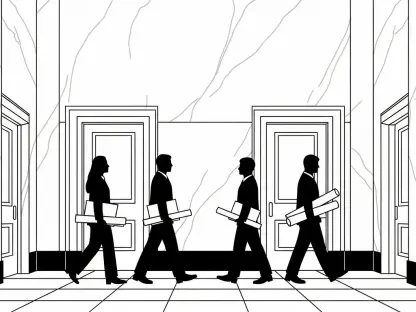In a landscape where homeownership is already a significant financial commitment, a surprising factor is adding to the burden for countless Americans: credit scores. Many homeowners are unaware that a dip in their credit rating can lead to staggering increases in home insurance premiums, sometimes costing thousands of dollars more each year. This hidden connection between personal finance and insurance affordability is becoming a critical issue, especially in states like Oklahoma, where the average annual home insurance cost is already a hefty $4,600. As financial pressures mount, the impact of credit scores on insurance rates is emerging as a silent but powerful force, exacerbating the challenges of maintaining affordable coverage. This revelation sheds light on a broader crisis, where unexpected financial hits can spiral into long-term struggles for those striving to protect their most valuable asset—their home.
Hidden Financial Risks in Insurance Premiums
The relationship between credit scores and home insurance costs often catches homeowners off guard, as it’s a factor rarely discussed when purchasing a policy. A lower credit score can result in premium increases of up to $5,600 annually, according to insurance experts who have studied trends across the nation. This substantial hike places an enormous strain on household budgets, particularly for those already grappling with high baseline costs. In regions with elevated insurance rates due to frequent natural disasters, such as tornado-prone areas, this additional expense can push coverage out of reach. Homeowners may not realize that insurers use credit-based insurance scores to assess risk, assuming that lower scores correlate with a higher likelihood of filing claims. This practice, while legal in many states, underscores a critical need for financial literacy, as maintaining a strong credit profile becomes not just a matter of securing loans but also of keeping essential protections like home insurance affordable.
Another layer of complexity arises when homeowners attempt to offset rising premiums by adjusting their policies, often without fully understanding the consequences. Opting for a higher deductible might seem like a practical way to lower monthly payments, but it can backfire if funds aren’t available to cover that deductible during a claim. This shortfall may force individuals to take on debt, which further damages credit scores and, in a vicious cycle, drives insurance costs even higher. The intersection of personal finance and insurance strategy becomes a tightrope walk, where a single misstep can lead to compounding financial woes. This dynamic highlights how interconnected financial decisions are, emphasizing that what appears to be a short-term fix can create long-term challenges. Homeowners must weigh these risks carefully, ensuring they have the resources to handle unexpected expenses without jeopardizing their credit standing or insurance affordability.
Environmental and Economic Pressures Amplify Costs
Beyond personal financial factors, broader environmental and economic trends are intensifying the home insurance crisis, making it a multifaceted challenge. The increasing frequency and severity of weather events—think floods, wildfires, and storms—linked to climate change are prompting insurers to raise premiums or even pull coverage from high-risk areas. These natural disasters not only threaten property and safety but also reshape the insurance landscape, leaving homeowners in vulnerable regions with fewer options and higher costs. As fossil fuel use continues to contribute to global warming, the ripple effects are felt in the form of escalating rates, forcing many to question whether they can afford to insure their homes at all. This trend paints a stark picture of disparity, where geographic location becomes as much a determinant of financial stability as individual creditworthiness, adding another layer of inequity to the housing market.
Economic pressures compound these environmental challenges, as inflation and rising rebuilding costs further drive up insurance premiums across the board. Insurers must account for the increased expense of materials and labor when setting rates, which means even homeowners with stellar credit scores aren’t immune to price hikes. This reality is particularly harsh in states already burdened by high insurance costs, where families may face the impossible choice between paying for coverage or risking catastrophic out-of-pocket expenses. The convergence of these macro-level forces with personal financial metrics like credit scores creates a perfect storm, threatening the dream of homeownership for a growing number of Americans. As premiums climb, the gap widens between those who can afford comprehensive protection and those who must gamble on going uninsured, highlighting a systemic issue that demands attention from policymakers and industry leaders alike to prevent further erosion of housing security.
Strategies for Managing Escalating Insurance Costs
Navigating the complex terrain of rising home insurance costs requires proactive steps and informed decision-making to mitigate financial strain. One effective approach is to review policies annually, ensuring coverage aligns with current needs and risks without overpaying for unnecessary protections. Consulting with an insurance agent can clarify confusing terms or options, helping homeowners avoid pitfalls like underinsurance or unexpected premium spikes due to credit issues. Additionally, considering a higher deductible should only be done if there’s confidence in having the savings to cover it during a claim, as this prevents the debt cycle that worsens credit scores. These strategies empower individuals to take control of their insurance expenses, balancing affordability with adequate protection in an era of rising costs. Staying vigilant about policy details and maintaining open communication with insurers can make a significant difference in managing the financial impact over time.
Another crucial aspect of cost management lies in addressing the root causes of premium increases, such as credit health, through deliberate financial planning. Monitoring credit reports regularly for errors or discrepancies can prevent unwarranted score drops that affect insurance rates. Paying bills on time and reducing debt are practical steps that bolster creditworthiness, which in turn can help secure more favorable premiums. Homeowners might also explore bundling home and auto insurance for potential discounts or shopping around for providers that weigh credit scores less heavily in their pricing models. These actions, while requiring effort and discipline, offer a pathway to stabilize costs in an unpredictable market. By focusing on both immediate policy adjustments and long-term financial habits, individuals can build resilience against the dual pressures of personal and environmental factors, safeguarding their ability to maintain essential coverage without breaking the bank.
Reflecting on Solutions for a Sustainable Future
Looking back, the mounting challenges of home insurance affordability revealed a stark reality for homeowners who grappled with the unexpected impact of credit scores on their premiums. The hefty annual increases, often reaching thousands of dollars due to a credit dip, compounded the burden in regions already facing high costs. Environmental threats from climate-driven disasters further intensified the struggle, as insurers adjusted rates to account for heightened risks. Yet, amidst these hurdles, actionable solutions emerged as a beacon of hope. Homeowners were encouraged to prioritize regular policy reviews, seek expert guidance, and strengthen credit health as vital steps to curb costs. Moving forward, advocating for broader industry reforms and policies that address both financial and environmental drivers of premium hikes became a critical consideration. These efforts aimed to ensure that homeownership remained within reach, offering a framework for resilience in an ever-changing landscape of risks and expenses.









